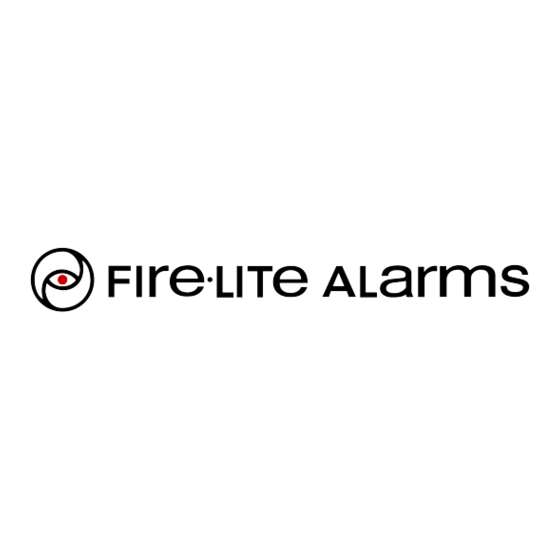Advertisement
INSTALLATION AND mAINTENANCE INSTRUCTIONS
CP355 Plug-in Addressable
Ionization Sensor
SPECIFICATIONS
Operating Voltage Range:
Maximum Average Standby Current:
Maximum Alarm Current (LED on):
Operating Humidity Range:
Operating Temperature Range
Height:
Diameter:
Weight:
GENERAL DESCRIPTION
This sensor must be installed in compliance with the control panel system
installation manual. The installation must meet the requirements of the Au-
thority Having Jurisdiction (AHJ). Sensors offer maximum performance when
installed in compliance with the National Fire Protection Association (NFPA);
see NFPA 72.
Model CP355 intelligent ionization sensor uses a state-of-the-art sensing cham-
ber. This sensor is designed to provide open area protection and is intended
for use with compatible control panels only.
Two LEDs on each sensor light to provide a local, visible sensor indication.
Remote LED annunciator capability is available as an optional accessory (Part
No. RA400Z).
The CP355 requires compatible addressable communications to function
properly. Connect this sensor to listed-compatible control panels only.
SPACING
Fire-Lite recommends spacing sensors in compliance with NFPA 72. In low
air flow applications with smooth ceilings, space sensors 30 feet apart. For
specific information regarding sensor spacing, placement, and special appli-
cations, refer to NFPA 72 or the System Smoke Detector Application Guide,
available from Fire-Lite.
WIRING GUIDE
All wiring must be installed in compliance with the National Electrical Code,
applicable local codes, and any special requirements of the Authority Having
Jurisdiction. Proper wire gauges should be used. The installation wires should
be color-coded to limit wiring mistakes and ease system trouble-shooting. Im-
proper connections will prevent a system from responding properly in the
event of a fire.
Remove power from the communication line before installing sensors.
1.
Wire the sensor base (supplied separately) per the wiring diagram, see
Figure 1.
2.
Set the desired address on the sensor address switches, see Figure 2.
3.
Install the sensor into the sensor base. Push the sensor into the base
while turning it clockwise to secure it in place.
4.
After all sensors have been installed, apply power to the control unit and
activate the communication line.
5.
Test the sensor(s) as described in the TESTING section of this manual.
6.
Tamper-Resistance
Model CP355 includes a tamper-resistant capability that prevents its
removal from the bracket without the use of a tool. Refer to the base
manual for details on making use of this capability.
7.
After all sensors have been installed, apply power to the system.
8.
See Figure 3. Test the sensor by positioning a test magnet against the sen-
sor plastic in the magnet test area. The alarm level should be recognized
at the panel and the LED controlled by communication command from
the panel.
9.
Reset the sensor by communication command from the panel.
FL-400-000
15 to 32 VDC
300µA@ 24 VDC (one communication every 5 seconds with LED blink enabled)
6.5 mA @ 24 VDC
10% to 93% Relative Humidity, Non-condensing
32°F to 120°F (0°C to 49°C)
2.0˝ (51 mm) installed in B350LP Base
6.1˝ (155 mm) installed in B350LP Base
5.4 oz. (153 g)
Dust covers provide limited protection against airborne dust particles during
shipping. Dust covers must be removed before the sensors can sense smoke.
Remove sensors prior to heavy remodeling or construction.
FIGURE 1. WIRING DIAGRAm:
REMOTE
ANNUNCIATOR
+
-
(+)
2
3
1
(–)
(–)
CLASS A OPTIONAL WIRING
(+)
FIGURE 2:
7
8
9
6
5
10
4
3
13
2
14
1 0
15
TENS
TESTING
Detectors must be tested after installation and following periodic maintenance.
However, before testing, notify the proper authorities that the smoke detector
system is undergoing maintenance and the system will be temporarily out
of service. Disable the zone or system undergoing maintenance to prevent
unwanted alarms.
Testing methods must satisfy the Authority Having Jurisdiction (AHJ). Sensors
offer maximum performance when tested and maintained in compliance with
NFPA 72.
Test the sensors as follows:
A.
Functional: Magnet Test (P/N M02-04-01 or M02-09-00)
This sensor can be functionally tested with a test magnet. The test mag-
net electronically simulates smoke in the sensing chamber, testing the
sensor electronics and connections to the control panel.
1. Hold the test magnet in the magnet test area as shown in Figure 3.
2. The sensor should alarm the panel.
Two LEDs on the sensor are controlled by the panel to indicate sensor
status. Coded signals, transmitted from the panel, can cause the LEDs
1
One FireLite Place
Northford, CT 06472
Phone: 203.484.7161
CAUTION
CAUTION: DO NOT LOOP WIRE
UNDER TERMINAL 1 OR 2.
BREAK WIRE RUN TO PROVIDE
SUPERVISION OF CONNECTIONS.
2
3
3
1
7
8
6
9
5
11
4
12
3
2
1 0
ONES
I56-3656-002R
2
1
C0129-00
C0162-00
Advertisement
Table of Contents

Subscribe to Our Youtube Channel
Summary of Contents for Fire-Lite Alarms CP355
- Page 1 Remove sensors prior to heavy remodeling or construction. see NFPA 72. FIGURE 1. WIRING DIAGRAm: Model CP355 intelligent ionization sensor uses a state-of-the-art sensing cham- CAUTION: DO NOT LOOP WIRE ber. This sensor is designed to provide open area protection and is intended REMOTE UNDER TERMINAL 1 OR 2.
- Page 2 CLEANING to blink, latch on, or latch off. Refer to the control panel technical docu- mentation for sensor LED status operation and expected delay to alarm. Before cleaning, notify the proper authorities that the system is undergoing maintenance and will be temporarily out of service. Disable the system to Smoke Entry: Aerosol Generator (Gemini 501) prevent unwanted alarms.



Need help?
Do you have a question about the CP355 and is the answer not in the manual?
Questions and answers